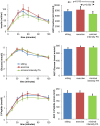Minimal intensity physical activity (standing and walking) of longer duration improves insulin action and plasma lipids more than shorter periods of moderate to vigorous exercise (cycling) in sedentary subjects when energy expenditure is comparable
- PMID: 23418444
- PMCID: PMC3572053
- DOI: 10.1371/journal.pone.0055542
Minimal intensity physical activity (standing and walking) of longer duration improves insulin action and plasma lipids more than shorter periods of moderate to vigorous exercise (cycling) in sedentary subjects when energy expenditure is comparable
Erratum in
- PLoS One. 2014;9(8):e105135
Abstract
Background: Epidemiological studies suggest that excessive sitting time is associated with increased health risk, independent of the performance of exercise. We hypothesized that a daily bout of exercise cannot compensate the negative effects of inactivity during the rest of the day on insulin sensitivity and plasma lipids.
Methodology/principal findings: Eighteen healthy subjects, age 21±2 year, BMI 22.6±2.6 kgm(-2) followed randomly three physical activity regimes for four days. Participants were instructed to sit 14 hr/day (sitting regime); to sit 13 hr/day and to substitute 1 hr of sitting with vigorous exercise 1 hr (exercise regime); to substitute 6 hrs sitting with 4 hr walking and 2 hr standing (minimal intensity physical activity (PA) regime). The sitting and exercise regime had comparable numbers of sitting hours; compared to the exercise regime, the minimal intensity PA regime had a higher estimated daily energy expenditure (238kcal/day) [corrected]. PA was assessed continuously by an activity monitor (ActivPAL) and a diary. Measurements of insulin sensitivity (oral glucose tolerance test, OGTT) and plasma lipids were performed in the fasting state, the morning after the 4 days of each regime. In the sitting regime, daily energy expenditure was about 500 kcal lower than in both other regimes. Area under the curve for insulin during OGTT was significantly lower after the minimal intensity PA regime compared to both sitting and exercise regimes 6727.3±4329.4 vs 7752.0±3014.4 and 8320.4±5383.7 mU•min/ml, respectively. Triglycerides, non-HDL cholesterol and apolipoprotein B plasma levels improved significantly in the minimal intensity PA regime compared to sitting and showed non-significant trends for improvement compared to exercise.
Conclusions: One hour of daily physical exercise cannot compensate the negative effects of inactivity on insulin level and plasma lipids if the rest of the day is spent sitting. Reducing inactivity by increasing the time spent walking/standing is more effective than one hour of physical exercise, when energy expenditure is kept constant.
Conflict of interest statement
Figures


References
-
- Haskell WL, Lee I-M, Pate RR, Powell KE, Blair SN, et al... (2007) Physical Activity and Public Health: Updated Recommendation for Adults from the American College of Sports Medicine and the American Heart Association. Medicine & Science in Sports & Exercise 39: 1423–1434 1410.1249/mss.1420b1013e3180616b3180627. - PubMed
-
- Katzmarzyk PT, Church TS, Craig CL, Bouchard C (2009) Sitting Time and Mortality from All Causes, Cardiovascular Disease, and Cancer. Medicine & Science in Sports & Exercise 41: 998–1005 1010.1249/MSS.1000b1013e3181930355. - PubMed
-
- Proper KI, Singh AS, van Mechelen W, Chinapaw MJM (2011) Sedentary Behaviors and Health Outcomes Among Adults: A Systematic Review of Prospective Studies. American Journal of Preventive Medicine 40: 174–182. - PubMed
-
- Healy GN, Dunstan DW, Salmon J, Shaw JE, ZIimmet PZ, et al... (2008) Television Time and Continuous Metabolic Risk in Physically Active Adults. Medicine & Science in Sports & Exercise 40: 639–645 610.1249/MSS.1240b1013e3181607421. - PubMed

